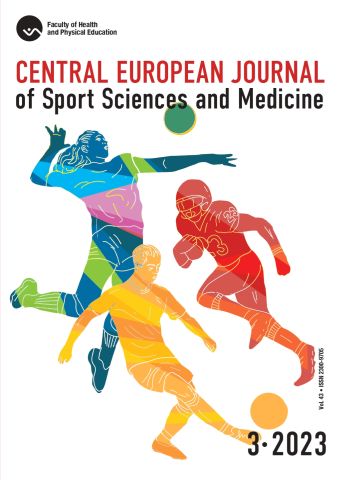
ISSN: 2300-9705
eISSN: 2353-2807
OAI
DOI: 10.18276/cej.2023.3-03




Lista wydań /
Vol. 43, No. 3/2023
Design and Validation of a Tool to Collect Student-Athletes' Perception of Their Satisfaction
| Autorzy: |
Josè M.
Palao

Department of Department of Health, Exercise Science and Sport Management, University of Wisconsin-Parkside, USA Bridget Jost 
Athletic Department, Madison College (Wisconsin), USA Janel Katzer 
Department of Department of Health, Exercise Science and Sport Management, University of Wisconsin-Parkside, USA Megan Parietti 
Department of Department of Health, Exercise Science and Sport Management, University of Wisconsin-Parkside, USA |
| Słowa kluczowe: | college sport tool student-athlete perception |
| Data publikacji całości: | 2023 |
| Liczba stron: | 12 (25-36) |
Abstrakt
The purpose of this study was to design and validate a tool to collect the student-athletes' perception of their satisfaction. The instrument collects information regarding student-athlete characteristics, self-perception, perception of training, perception of team/teammates, perception of the program organization, and perception of the support received. The design and validation, of the questionnaire were done in two phases: a) design and development of the instrument, and b) content validation by experts. The results show that the tool is suitable for obtaining information about student-athletes' perception of their satisfaction. The implementation of the tool involves two phases: a) student-athletes completion of a survey and b) student-athletes and moderator carry out a group discussion regarding the causes behind their answers, things to maintain, and things that could change or improve. The tool developed and validated could contribute to increase the information of student-athletes about their experience and generate communication channels.
Pobierz plik
Plik artykułu
Bibliografia
| 1. | Bulger, S. M., & Housner, L. D. (2007) Modified Delphi investigation of exercise science in physical education teacher education. Journal of Teaching in Physical Education, 26, 57–80. |
| 2. | Caliskan, G., & Baydar, H. O. (2016). Satisfaction scale for athlete (SSA): A study of validity and reliability. European Scientific Journal, 12(14). |
| 3. | Chelladurai, P., & Riemer, H. A. (1997). A classification of facets of athlete satisfaction. Journal of sport management, 11(2), 133–159. |
| 4. | Cox, R. H., Sandstedt, S. D., Martens, M. P., & Ward, D. G. (2004). Development of the student-athlete experiences inventory. Journal of Sport Behavior, 27(3), 243. |
| 5. | Duderstadt, J. J. (2000). Intercollegiate athletics and the American university. Ann Arbor, MI: The University of Michigan Press. |
| 6. | Durham, M. (2020, January 23). 2020 GOALS study results shared at NCAA Convention. NCAA.org. Retrieved from https://www.ncaa.org/about/resources/media-center/news/2020-goals-study-results-shared-ncaa-convention |
| 7. | Escurra, L. (1989). Cuantificación de la validez de contenido por criterio de jueces [Quantification of content validity through judge criteria]. Revista de Psicología, 6, 103–111. |
| 8. | Gaston-Gayles, J. L. (2005). The factor structure and reliability of the student athletes' motivation toward sports and academics questionnaire (SAMSAQ). Journal of College Student Development, 46(3), 317–327. |
| 9. | Hague, P., Hague, N., & Morgan, C. (2004). Market research in practice: A guide to the basics. London: Kogan Page. |
| 10. | Landis, J. R.; & Koch, G. G. (1977). The measurement of observer agreement for categorical data. Biometrics, 33(1), 159–174. doi:10.2307/2529310 |
| 11. | Miller, R. (2003). The role of athletics in higher education. Major Themes in Economics, 5(1), 31–47. |
| 12. | National Collegiate Athletic Association (2015, January 13). History of the NCAA student athlete advisory committee. Retrieved September 15, 2020, from http://www.ncaa.org/student-athletes/history-ncaa-student-athlete-advisory-committee |
| 13. | National Collegiate Athletic Association (2017, June). GOALS and SCORE studies. Retrieved from http://www.ncaa.org/about/resources/research/ncaa-goals-study |
| 14. | Padilla, J. L., Gómez, J., Hidalgo, M. D., & Muñiz, J. (2007). Esquema conceptual y procedimientos para analizar la validez de las consecuencias del uso de los test [Conceptual diagram and procedures to analyze the validity of the consecuences of test use]. Psicothema, 19(19), 173–178. |
| 15. | Penfield, R. D., & Giacobbi, P. R. (2004) Applying a score confidence interval to Aiken’s item content-relevance index. Measurement in Physical Education and Exercise Science, 8(4), 213–225. |
| 16. | Renick, J. (1974). The use and misuse of college athletics. The Journal of Higher Education, 45(7), 545–552. |
| 17. | Riemer, H. A., & Chelladurai, P. (1998). Development of the athlete satisfaction questionnaire (ASQ). Journal of sport and exercise psychology, 20(2), 127–156. |
| 18. | Smith, W. (2010). Athlete satisfaction and the peak event: adapting the athlete satisfaction questionnaire (ASQ) to a New Zealand setting. Massey University, School of Business. |
| 19. | Thomas, S. J. (2004). Using web and paper questionnaires for data-based decision making: From design to interpretation of the results. Thousand Oaks, CA: Corwin Press. |
| 20. | Trochim, W. & Donnelly, J. P. (2007). The research methods knowledge base (3rd Edition). Mason, OH: Cengage Learning-Atomic Dog. |
| 21. | Zhu, W., Ennis, C. D., and Chen, A. (1998) Many-faceted Rasch modelling expert judgment in test development. Measurement in Physical Education and Exercise Science, 2(1), 21–39. |